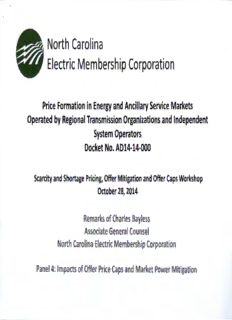
Price Formation in Energy and Ancillary Service Markets Operated by Regional Transmission ... PDF
Preview Price Formation in Energy and Ancillary Service Markets Operated by Regional Transmission ...
Price Formation in Energy and Ancillary Service Markets Operated by Regional Transmission Organizations and Independent System Operators Docket No. AD14-14-000 Scarcity and Shortage Pricing, Offer Mitigation and Offer Caps Workshop October 28, 2014 Remarks of Charles Bayless Associate General Counsel North Carolina Electric Membership Corporation Panel 4: Impacts of Offer Price Caps and Market Power Mitigation Price Caps • Price Caps are necessary in RTOs and ISOs to mitigate market power and to protect customers from unreasonable prices during periods of capacity deficiency or emergency. • Removing price caps to increase demand response should not be done at the expense of customers who incur substantial cost increases for minor increases in generation. 2 Mitigation Rules • Mitigation rules are designed to ensure that resources are able to bid their marginal costs, but not able to exercise market power. • Mitigation procedures are based on the premise that in a competitive wholesale electricity market, a resource's offer will be approximately equal to its short-run marginal cost (including opportunity costs). 3 Background • FERC Order 719 required RTOs and ISOs to reform their market rules to ensure that energy prices, during an operating reserve shortage, will appropriately reflect the value of energy. - Fixed prices seen by retail customers do not reflect the true value of energy; therefore retail customers are not able to react to changes in the wholesale market. - Lack of a price signal to retail customers leads to over consumption during shortages. • FERC Order 719 expressed the view that the wholesale electric power market works best when demand can respond to the wholesale price: The vast majority of demand can not see the real price of electricity during shortages causing overconsumption and dramatic wholesale price spikes. - Where demand response received incentive compensation, the true cost to all consumers of demand response provided by some consumers exceeds the compensation required for a manufacturer to stop production and is far in excess of what any consumer would pay for electricity if they saw the true incentive price. 4 Intersection of the Free Market and the Regulated Market Market Regulated • Price spikes and scarcity prices are a result of the relation between market based prices established in the wholesale market and fixed prices that are set in the retail market: GJ ·u- Invisible Regulated, - Prices vary in the wholesale market as supply and demand varies. '- Hand Cost of Service Q. - The retail market has regulatory determined fixed prices that remain for months or years. • Inability of retail demand to see the wholesale price signal feeds back into > ·- Regulated, the wholesale market in the form of ~ higher demand: Invisible Certificates of ~ c - The effect of this feedback is more Hand Convenience ta pronounced during shortages caused by :::J extreme weather events. a and Necessity - Retail rates established by states. 5 Supply Curve Total Installed Capacity cv ·.u-.. Q. Megawatts • The supply curve is the marginal cost of generation. • At 11Totallnstalled Capacity" all generation is running: - There is no additional generation available at any price. 6 Theoretica I Supply and Demand •Demand curves are a function of Price, Time-of-Day, Temperature, etc. •Market Clearing Demand (MCD)-Theoretical price and quantity in a "market" Marginal Cost Supply Curve MCD ~~ GJ ·u- ">Jq,/). c~. tY)' ~~ :./ ">Jq,/). tY)' 9 Quantity (MW) 7 Actual Supply and Demand Actual Demand (AD)- Quantity required using customer-perceived supply curve ()~ ~~~ C1J ·u- ()#)' '- 9 0.. 1----------~ Customer Perceived Supply Curve AD Quantity {MW) •Customers with fixed rates see a flat demand curve with unlimited supply. •Customers will consume a quantity equal to actual demand . 8 Actua I Demand vs. Theoretica I Demand Marginal Cost Total Installed Supply Curve cu ·u- '- c.. Customer Perceived Supply Curve Quantity {MW) •MCD- Customer theoretical demand •AD- Customer demand under the regulated market •Because Actual Demand exceeds the total installed capacity, supply cannot meet demand 9 Market Construct Failures • As demand approaches and exceeds the total installed capacity, wholesale price spikes occur: - Consumers see a flat supply curve; there is no incremental price for the next unit, resulting in undiminished demand. - However, as the installed capacity limit is approached, generation becomes more expensive and inelastic, meaning dramatically higher prices are needed to get this generation to produce. - Over-consumption, uninformed by price signals, either creates or dramatically exacerbates the shortage. • Once the total installed capacity is surpassed, no price will incent additional generation. 10
Description: